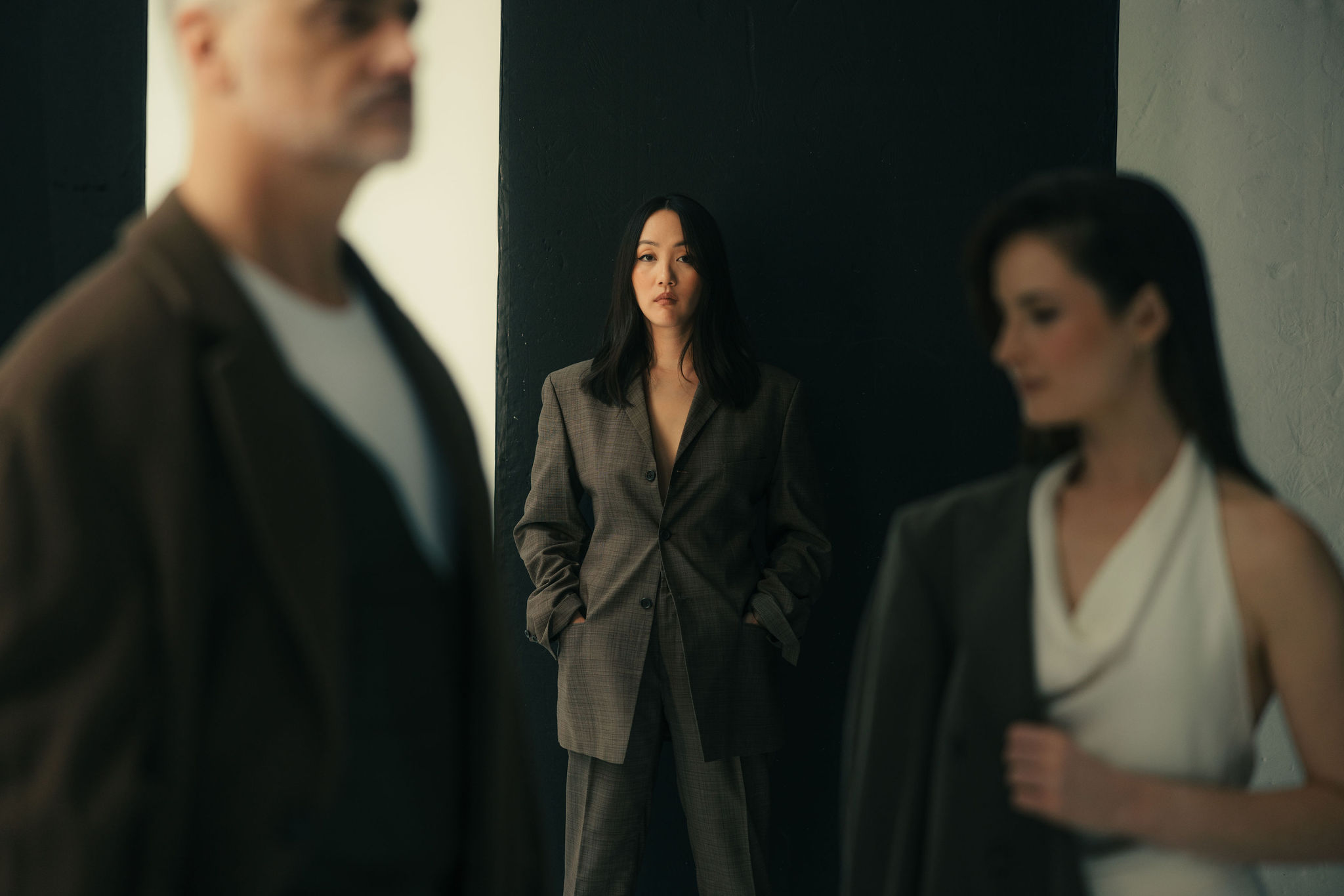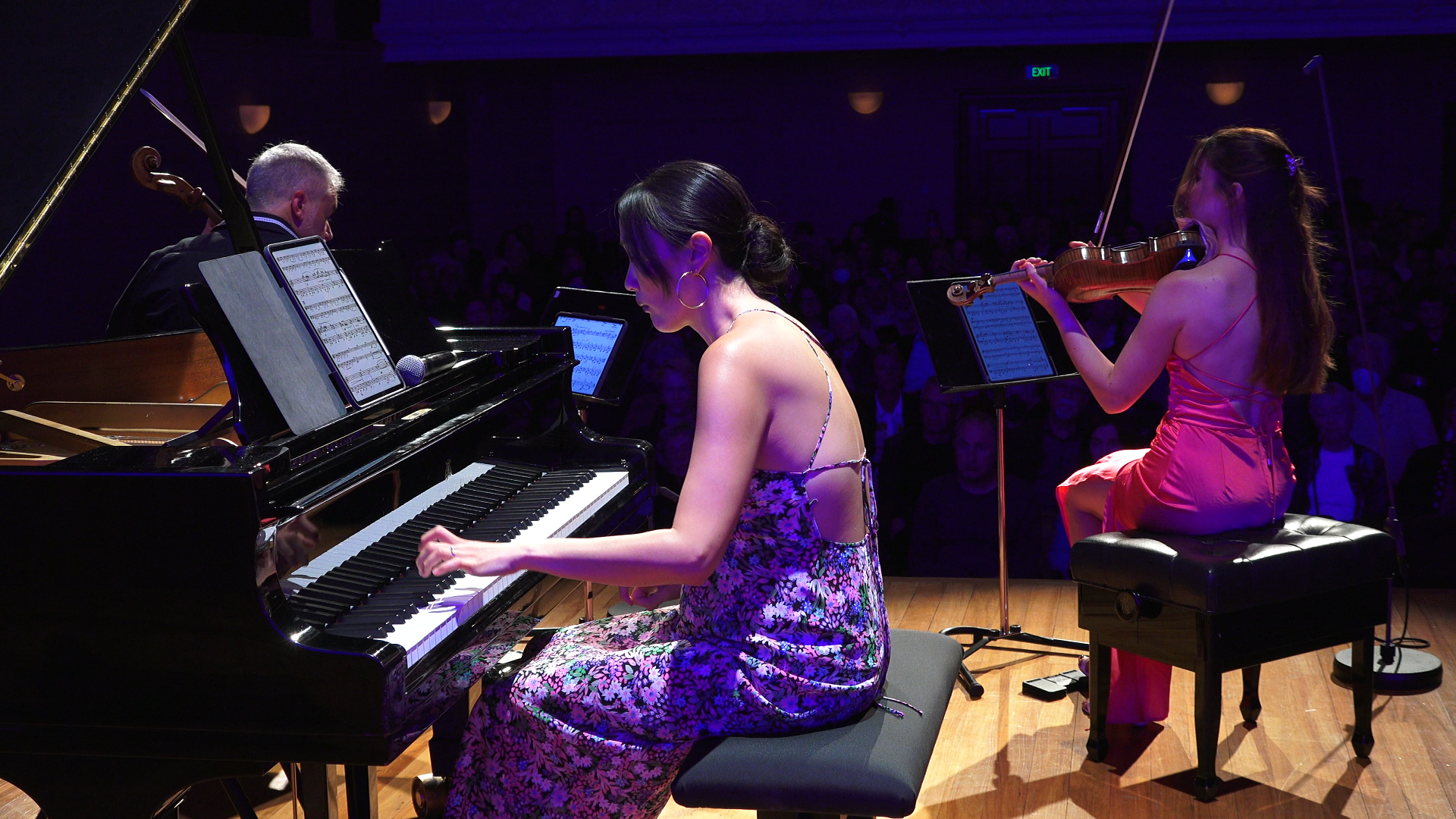NZTrio could easily, un-facetiously be dubbed the rockstars of the New Zealand classical music scene. It’s not just that Justine Cormack (violin), Ashley Brown (cello) and Sarah Watkins (piano) are eminently marketable bright young things dressed by WORLD that earns them this plaudit: they are one of New Zealand’s top chamber groups that offers audiences some of this country’s most adventurous programming, as well as being fierce exponents of new and New Zealand music. . .
. . .Within a generally sparse and delicate texture [of Victoria Kelly’s Toi Huarewa], we were at liberty to enjoy the richly colourful sounds of both the taonga puoro and the unusual noises of the piano trio which beautifully complemented the array of Maori instruments. Sometimes the trio writing imitated the sounds of the taonga puoro, although the relationship between the two moved beyond mere mimicry and developed sounds and textures that were greater than the sum of their parts.
Celeste Oram – Craccum Magazine: The University of Auckland Student Magazine, 15 April 2013
NZTrio could easily, un-facetiously be dubbed the rockstars of the New Zealand classical music scene. It’s not just that Justine Cormack (violin), Ashley Brown (cello) and Sarah Watkins (piano) are eminently marketable bright young things dressed by World that earns them this plaudit: they are one of New Zealand’s top chamber groups that offers audiences some of this country’s most adventurous programming, as well as being fierce exponents of new and New Zealand music.
This programme, entitled ‘Convergence’, comprised works by both contemporary Chinese and New Zealand composers, featuring taonga puoro (traditional Maori instruments) in addition to the regular piano trio lineup. In their post-concert talk, the trio described the programme as a way for letting two different cultures take a few steps towards each other. Such a statement begs the question of whether those steps can be trodden without using compromise as a stepping-stone – and whether such compromise should be regarded as an abandonment and ‘selling out’ of cultural authenticity, or whether it can spawn new and intriguing musical possibilities.
Any work which seeks to blend Western instruments with taonga puoro immediately runs up against the challenge of the massively different sound-worlds they inhabit. Many taonga puoro can be quite soft, and their beauty stems from subtle shifting of sonic nuances; it’s the kind of music that makes you focus an aural microscope on very delicately spun sound. By contrast, Western instruments have been carefully engineered over centuries to make a lot of sustained noise. So the fight is somewhat fixed, and it takes a great deal of sensitivity on the part of performer and composer to successfully blend the two.
The first piece on the programme was by New Zealand composer Gareth Farr: a busy and well-known composer thanks to his ‘Drum Drag’ alter-ego Lilith Lacroix, and his popular orchestral works such as From The Depths Sound the Great Sea Gongs. Farr’s piece in this programme, Nga Kete e Toru, featured performances from legendary authority on taonga puoro Dr. Richard Nunns, as well as internationally acclaimed taonga puoro player Horomona Horo.
I was not convinced that Farr’s marriage of Maori and Western instruments was an entirely happy one in this work. The piece took its structure and content from the eponymous myth of Tane’s quest for the three baskets of knowledge; but it felt like the piano trio told the story by chugging along through somewhat generic, quasi-cinematic musical language, while the taonga puoro were episodically showcased as if on display in glass vitrines. The stubbornly rooted Western musical language did not seem to go out of its way to side-step towards its Maori counterpart.
At the heart of the concert were two works by Chinese-born composers: firstly, Su Xie Si Ti (Four Sketches) by Gao Ping, now based in New Zealand as a lecturer in composition at Canterbury University. Of these vivid, concise sketches, the most memorable was the third, ‘Counterpoint’, which Gao based on a memory of a village funeral procession in rural China. A plaintive cello played a keening lament alongside the heavy-footed procession of sonorous piano chords, while offstage the violin played an incongruously chirpy tune, making the onstage drama seem even more pitiable.
Chen Yi is a significant living composer, as one of the best-known Chinese composers in the West (now based in the States). In her piece Tibetan Tunes, the trio did a fine job of evoking the silvery timbre of the erhu, the Chinese fiddle. The violin and cello spun a nimbly ornamented melody reminiscent of Tibetan folk music, while the piano’s spacious, rugged arpeggios seemed to evoke something of Tibet’s vast lunar landscape in contrast to the domestic intimacy of the folk instruments.
New Zealand composer Victoria Kelly’s offering to the programme, Toi Huawera/Suspended Way was a more thoughtful approach to the blending of Western and Maori instruments, as evidenced by the comprehensive programme note and short film which elucidated her working process: a close collaboration with both the trio and with Horomona Horo.
Within a generally sparse and delicate texture, we were at liberty to enjoy the richly colourful sounds of both the taonga puoro and the unusual noises of the piano trio which beautifully complemented the array of Maori instruments. Sometimes the trio writing imitated the sounds of the taonga puoro, although the relationship between the two moved beyond mere mimicry and developed sounds and textures that were greater than the sum of their parts.
With a varied programme whose works exhibited numerous aesthetic approaches to the notion of cultural ‘Convergence’, this concert had the potential to be a provocative exploration of the complex contradictions that arise from this ultimately unanswerable question of how two cultures can ‘take a few steps towards each other’. Yet neither the programme notes nor the post-concert talk explicitly addressed this, and potential controversy was swept under the carpet rather than grappled with. Although it was disappointing to not hear more from the artists’ perspectives on these issues, the vibrant and outstanding musical performances of the NZTrio, Richard Nunns and Horomona Horo showcased the works on the programme in their best possible light, leaving the audience to linger alone over the many unanswered questions which the concert raised.
Celeste Oram – Craccum Magazine: The University of Auckland Student Magazine, 15 April 2013

